Iphone 7 vs galaxy s7 comparison. Design, case materials, protective functions. Green grass after rain
Original models Galaxy S7 and iPhone 7 from Samsung And Apple are fierce competitors and occupy first and second places in mobile market. Both companies create their flagships with an eye on their opponent. This spurs competition. Let's compare these models.
1 – size
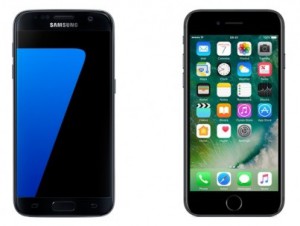
The iPhone is 4mm lower and 3mm narrower, as well as 0.8mm smaller at the waist. In terms of compactness, it looks more advantageous.
2 – weight
Wherein new iPhone a full 10 percent lighter: 138 grams versus 152.
3 – building
The iPhone's aluminum case has lost its plastic antenna inserts. Now they are hidden inside the case and the body has become monolithic, which also adds to the strength of the case. Samsung almost traditionally presents a combination of metal and glass. This approach looks more colorful, but is not as reliable as the opponent’s.
4 – water protection
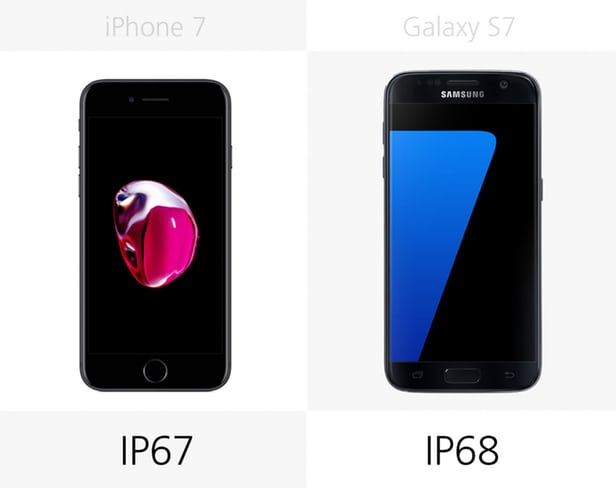
In terms of protection from water and dust, both smartphones stand close to each other. They are not afraid of diving to a depth of about a meter. And it is worth noting that the iPhone 7 received such protection for the first time. True, we had to sacrifice the headphone jack.
5 – colors
To the entire color palette of the new iPhone case, consisting of gold, silver, black and rose gold, the new model has added a “matte black” shade. Samsung offers a choice of classic black, silver and gold.
6 – display
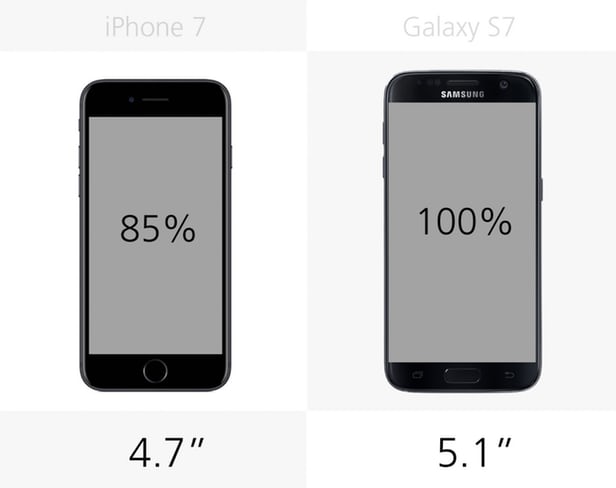
The new iPhone is slightly smaller in size, but also makes worse use of usable space, losing 0.4 inches on the screen. And the list of defeats doesn’t end there: it has an IPS screen versus an AMOLED screen (which means it’s less bright, dynamic and contrasty), the picture resolution is worse (1334 by 326 pixels versus 2560 by 1440 pixels) and there is no “always-on screen” option " True, there is a function for understanding the force of pressing the screen - Touch Force, which the opponent does not have.
7 – buttonHome and user identification sensors
The Home key on the front of the iPhone has become multitasking and gained tactile feedback. The fingerprint sensor remains the same. The Home button on Samsung's smartphone has not changed, and it also still houses the fingerprint sensor.
8 – virtual reality
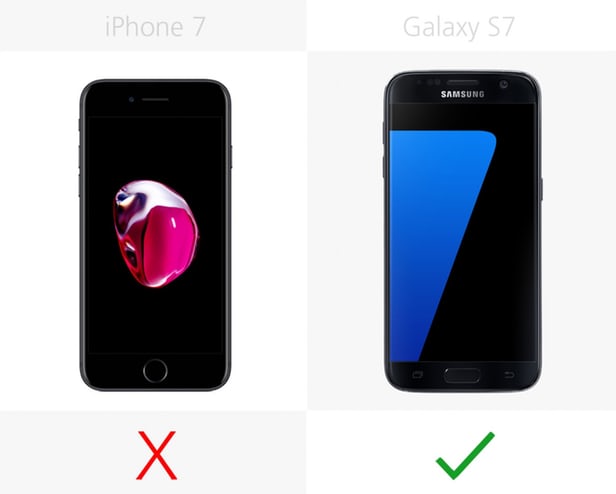
There is such a headset - Samsung Gear VR. It allows the device from the South Korean manufacturer to be in an additional world. Apple does not give this option to its devices.
9 – cameras
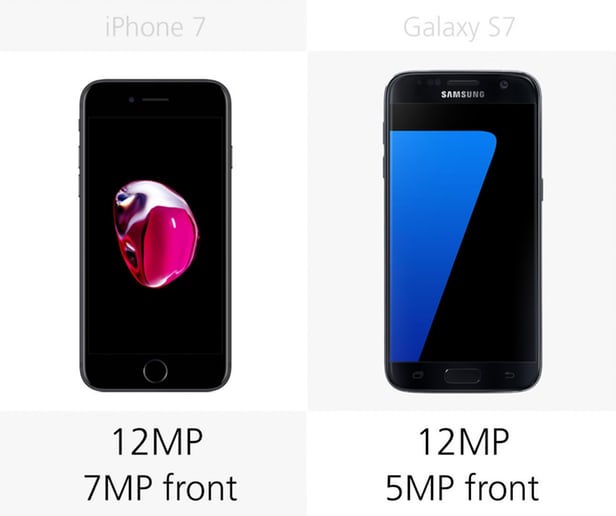
The main cameras are, in principle, equivalent in characteristics and offer excellent pictures and videos as output. Front-camera the iPhone has improved and is better than its opponent, however, the lens aperture still captures more light in the Samsung (f/1.7 versus f/1.8). Both smartphones support optical image stabilization.
10 – battery
The battery capacity of the new iPhone is still unknown, while Samsung’s smartphone has 3000 mAh. Let’s add here the possibility of fast charging and wireless charging, which Apple never provided iPhones with.
11 – memory
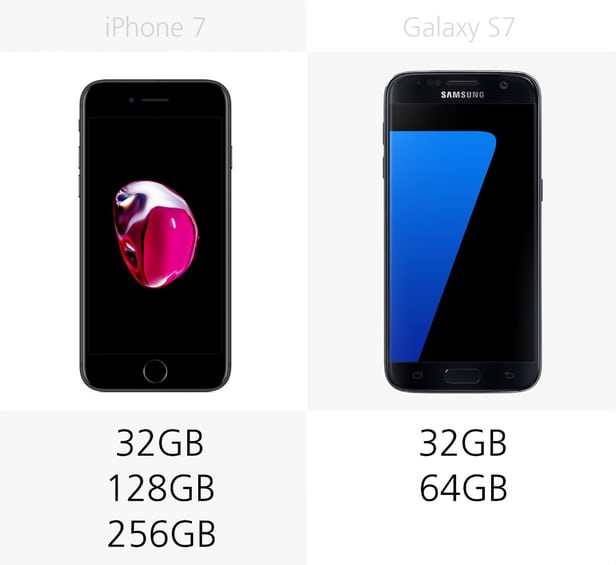
The iPhone is now sold in a minimum configuration with 32 GB of memory. Samsung has been doing the same for its flagships for a long time. Apple surprises with 128 and 256 GB options without support for a removable memory card. Whereas to the 64 GB of memory of the Galaxy S7, you can add up to 2 TB of information.
12 – mobile payments
Samsung Pay vs Apple Pay.
13 – software

iOS 10 has gone to update all iPhones over the past 3 years or is offered right out of the box. While the Samsung smartphone still runs on Android Marshmallow and is waiting for an update to Nougat.
14 – release, price and withdrawal
In March 2016, the original Samsung Galaxy S7 with a price tag starting at $670. In September 2016, the original iPhone 7 began to be distributed with a price starting from $649. Both smartphones look like worthy competitors even with a six-month difference in their launch to the market. Both are beautiful, fast, don't sink, and use the cutting-edge features of their platforms. The choice may seem more difficult than the user expects.
The time has finally come when we can make this comparison! The CHIP editorial team always rejoices at the day of presentation new iPhone, since then the idea of everyone flagship models of the current year, and therefore all the innovations in the world mobile phones, becomes full.
So, what technical delights did Apple implement in the iPhone 7 that Samsung did not provide in the Galaxy S7, or in what ways is the South Korean flagship ahead of the American Apple Phone? CHIP also compares according to technical data made known on Keynote. In the table below you can find all the specifications, and a little further we will discuss the biggest differences between these two smartphones in more detail.
Samsung Galaxy S7 compared to iPhone 7
| Characteristics | Samsung Galaxy S7 | iPhone 7 |
| CPU | Exynos 8890 (Octa-Core, 2.3 GHz, 64-bit) | Apple A10 (4-Core, ??? GHz, 64-bit) |
| RAM | 4 GB | ??? GB |
| Camera | 12 megapixels | 12 megapixels |
| Display | 5.1 inches | 4.7 inches |
| Screen resolution | 2560 x 1440 pixels | 1334 × 750 dots |
| Net | LTE Cat9 | LTE Cat9 |
| Battery capacity | 3000 mAh | tba mAh |
| Inner memory | 32 GB (expandable) | 32 GB, 128 GB, 256 GB |
Samsung Galaxy S7 vs iPhone 7: camera
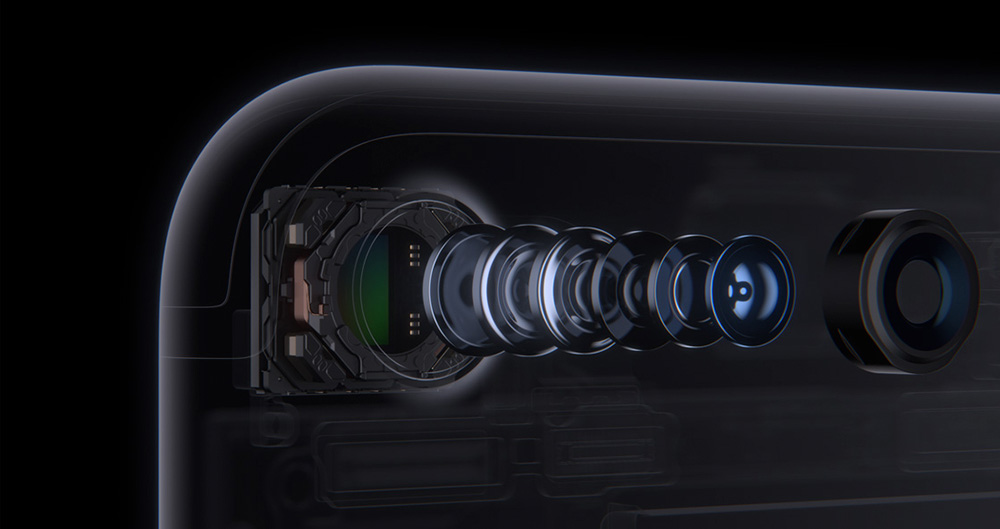 The new dual camera is only available on the iPhone 7 Plus; the small iPhone 7 doesn't have it.
The new dual camera is only available on the iPhone 7 Plus; the small iPhone 7 doesn't have it. The big difference between the iPhone 7 and Galaxy S7 can be found in the camera specs. At a traditional event called Keynote, Apple showed off its iPhone 7 Plus with a special new dual camera.
It should give smartphone photos a visual similarity to photos taken with DSLR cameras and provide the ability to use both wide-angle and telephoto lenses.
The resolution of the new iPhone remains the same as before - 12 megapixels. Interestingly, the small iPhone 7 does not come with a dual camera. Instead, it offers an old but improved one with optical image stabilization.
Samsung company in production Galaxy cameras S7 uses special technology Dual Pixel, known to us from Canon SLR cameras. It allows you to achieve autofocus speeds hitherto unprecedented for the mobile phone segment.
We find the appearance of the photos taken during the test tests to be really good. Especially in conditions poor lighting The 12-megapixel camera demonstrates the ability to take really very bright pictures with low noise levels.
This is largely due to the maximum open aperture setting - f1.7. However, it also entails such a disadvantage that the edges of the image turn out to be somewhat blurred. For connoisseurs, there is also a “professional” mode with the ability to manually adjust exposure.
Samsung Galaxy S7 vs iPhone 7: memory and performance
 Tests will show whether the iPhone 7 can supplant the Galaxy S7
Tests will show whether the iPhone 7 can supplant the Galaxy S7 And with the release of the iPhone 7, Apple remained true to its credo: it will still be impossible to expand the built-in memory. But the Californians presented a version with an even larger amount of built-in storage, with a capacity of 256 GB. But in Samsung, on the contrary, heard the criticism of S6 fans and began to reintegrate the memory card slot.
As for the differences or similarities in terms of performance, we can only make assumptions for now. The Apple A10 processor should have even greater performance than its predecessor, which was also quite fast and handled iOS 10 quite well. Applications launched without any delays, and the operating system ran smoothly.
However, there will be a slight difference with its predecessor, but compared to the Galaxy S7 it will be much smaller. Samsung has equipped its flagship with a powerful eight-core processor that runs the operating system. Android systems. During the test it worked absolutely without delay - however, what will happen with subsequent updates?
To summarize, we can say that in terms of “technical” performance, smartphones should be approximately at the same level. We look forward to the results of full testing!
Samsung Galaxy S7 vs iPhone 7: Other Differences
Often the primary focus when making a purchase is the camera, memory, and performance. But of course, characteristics such as design, Internet speed, display, and the presence of various functionality also play an important role.
In terms of design, Apple has moved a little further, as its smartphone camera is no longer enclosed in a metal frame, but is finally recessed into the body. In addition, there are new body colors. Visually, the iPhone 7 looks even slightly sleeker than its predecessor, and we find the aluminum finish to be more plush than the S7's glass back. However, both devices are waterproof and offer LTE Cat 9, and the Galaxy S7 has a classic headphone jack.
In terms of display, we give the S7 a slight advantage. Although its screen is not pressure sensitive, it has a higher resolution and is created using OLED technology.
Today we will try to compare two very interesting smartphone. Of course, these will be representatives of the two most important competitors on the market: iPhone 7/7 PLUS and Samsung Galaxy S7/S7 Edge.
You can, of course, say that there are two smartphones on each side, but their characteristics are very similar and therefore, we will simply compare in general, but I will take into account all the points.
I know that the article is being published much later than it should have been. But considering that quite a lot of time has passed and all the devices are still relevant, then why not.
What is the difference between iPhone 7/7 PLUS and Samsung Galaxy S7/S7 Edge?
As you can imagine, comparisons are usually not very equal, because companies release devices at completely different times of the year. In any case, someone is one step ahead.
Therefore, let's first compare all the characteristics in the table. Thus, you can understand the most important differences between these gadgets.
Approximately such differences can be observed in the general picture in the table. But we understand that each point must be considered separately.
Lately, the numbers don't always tell the truth. You need to experience everything live and understand the difference. What are we going to do now?
The difference between iPhone 7/7 PLUS and Samsung Galaxy S7/S7 Edge
Let's start with the most interesting part. I won't go into great detail. But after reading the article, you will understand the main difference.
Design
Although the iPhone 7 did not receive anything radically new in its design, Apple managed to make a new device out of the old 6S thanks to bug fixes. 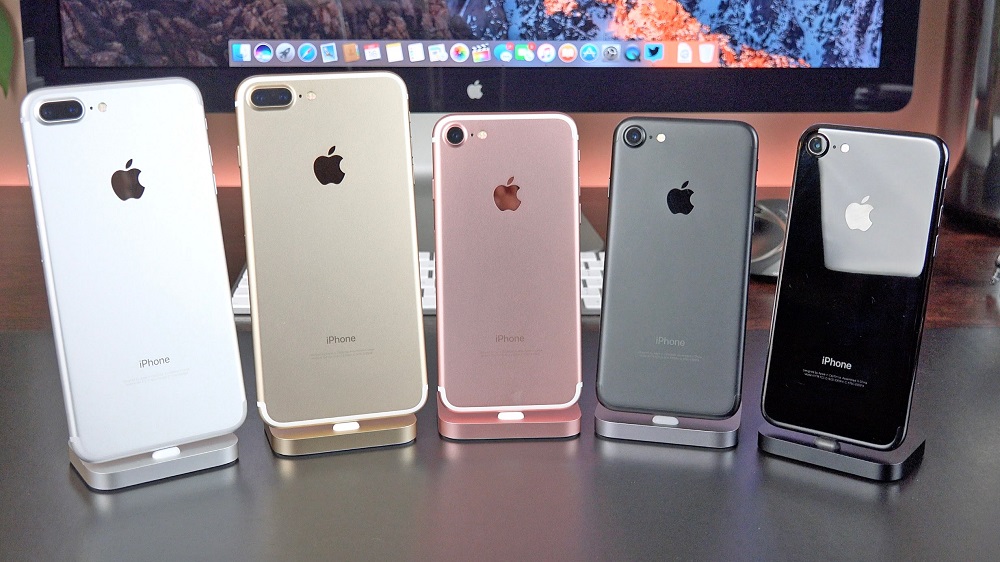
Now the antennas neatly follow the contour of the body, the camera has become much more pleasant to look at thanks to the one-piece body. And this is perhaps all the main differences from the previous model in appearance.
Three new color options have appeared and now you can also buy Red, Black (Matte) and Jet Black. Well, in the old fashioned way you can find Gold, Rose Gold and Silver.
Samsung managed to do something new and fascinating. If regular Galaxy The S7 is very similar to its predecessor, but the Edge was able to distinguish itself very much thanks to its screen. 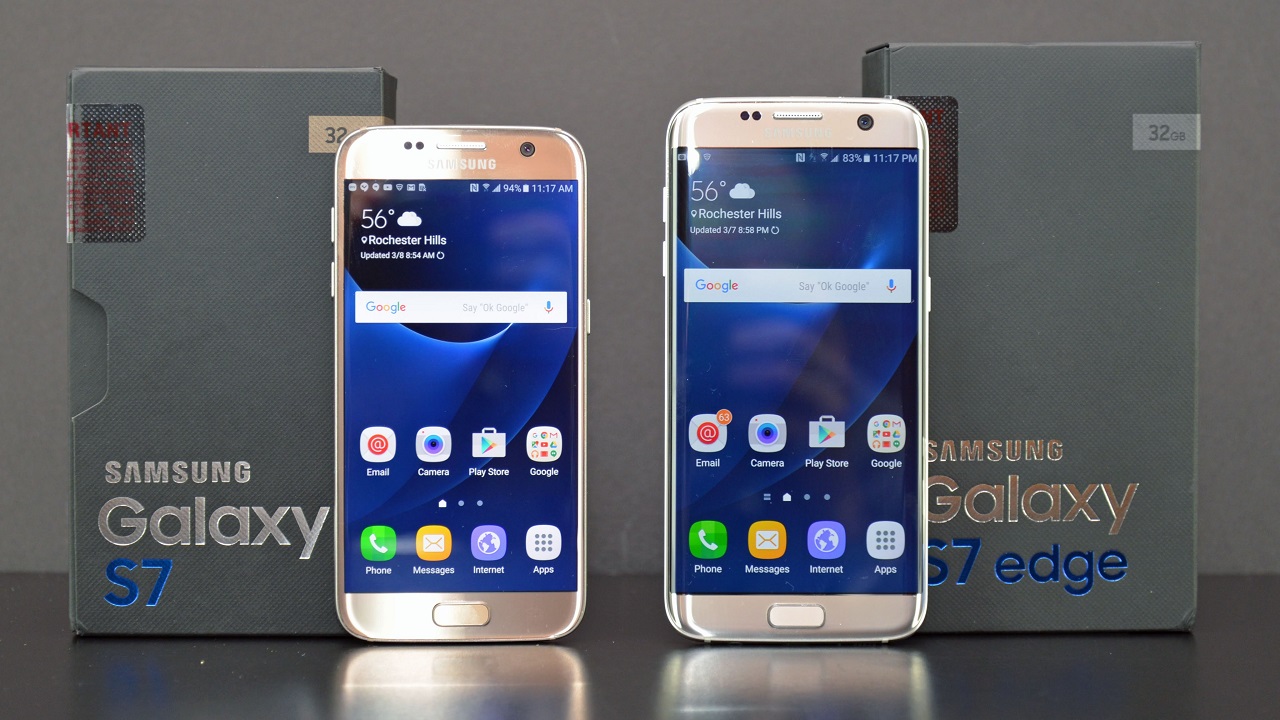
On the sides, the device has a curved screen. I have no doubt, it all looks very cool. But as practice shows, using the device is not as convenient as expected.
Very often, it is these side parts that react to accidental pressing and, of course, when playing games and watching videos, holding the device is extremely uncomfortable. 
The colors are completely different and we have “black diamond”, “white pearl”, “silver titanium” and “dazzling platinum”.
It is quite difficult to say which design is better, because each user has his own ideals and point of view. Both are good in their own way and it’s up to you to decide which one is more beautiful.
Here I can add at the end that iPhone case made of aluminum and after a couple of years it looks much nicer than the Galaxy S7.
The reason was the plastic speaker and Menu button, which simply wear off after a while. However, the glass body is very good.
Screens
As you already know: the iPhone has 4.7 and 5.5 inches, and the Samsung has 5.1 and 5.5 inches. If the younger models are approximately the same, then regarding the larger options we can say that Samsung 5.5 is more accurate.
Apple usually doesn't chase resolutions, because they want to perfectly optimize everything and extend battery life. 1334x750 and 1920x1080 - although not enough, users are not complaining so far. 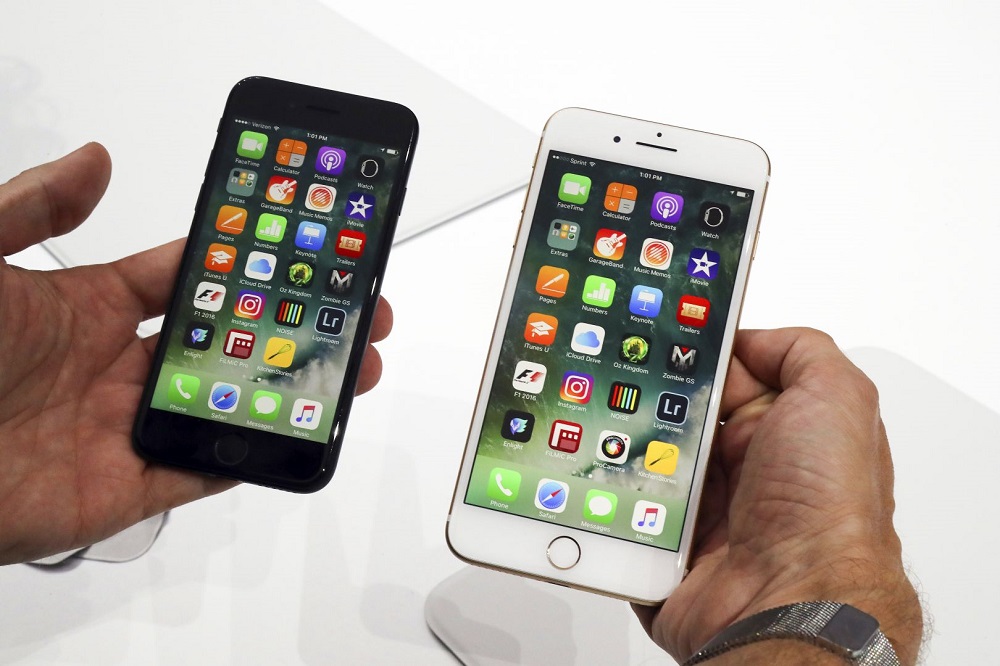
It can also be noted that they have the best on the market IPS matrix, which is a slight improvement over the 6S.
For Samsung, everything is a little different and they have long felt confident in this regard. Super AMOLED has incredible color reproduction. 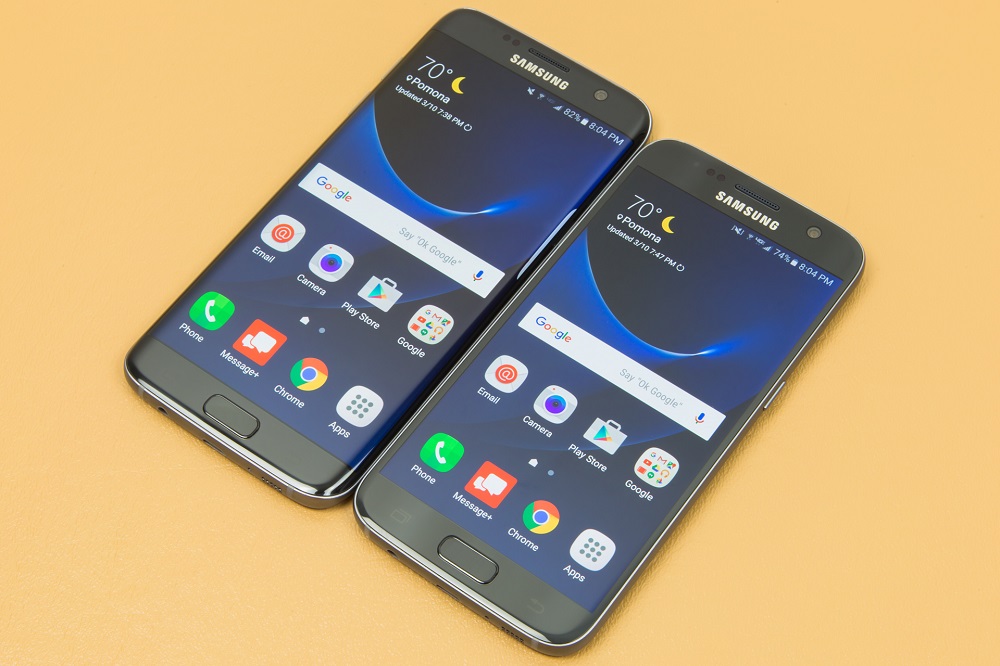
2560x1440 is quite good for such dimensions and in this regard you will feel very comfortable. The black color is really black, unlike IPS.
But to be honest, both screens are quite High Quality and have everything you need for top-end devices. Again, color rendering is a matter of taste.
Batteries
And here comes the first point, which Apple has not been able to catch up with for quite a long period of time. Of course, these are batteries and everything connected with them.
Almost all devices show good performance in terms of operating time, except for the iPhone 7. Thanks slim body managed to accommodate only 1960 mAh. 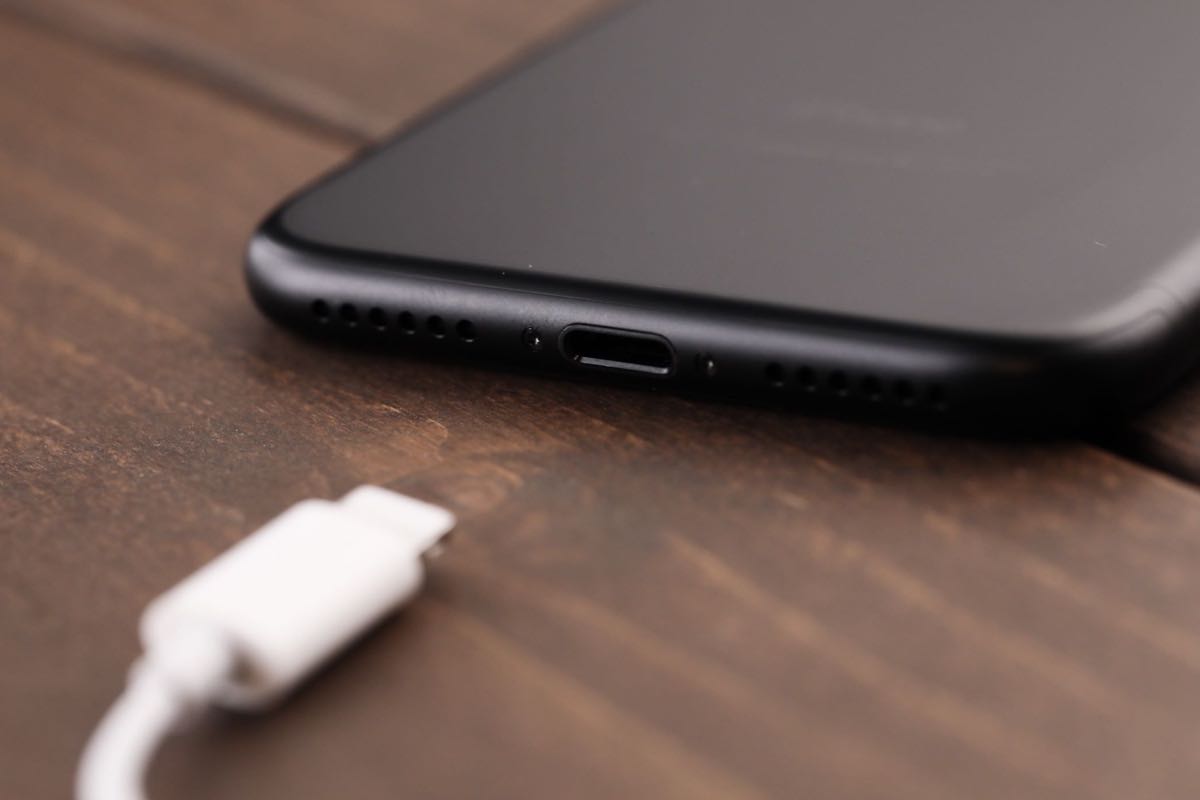
But this is not the most important thing. It will take you a full 2 hours and 10 minutes to fully charge your iPhone 7. While for Samsung S7 it will take only 1 hour and 25 minutes.
All thanks to technology Quick Charge 2.0, which they have been using for quite some time. Also, just think for a second that 50 percent can be achieved in just half an hour. 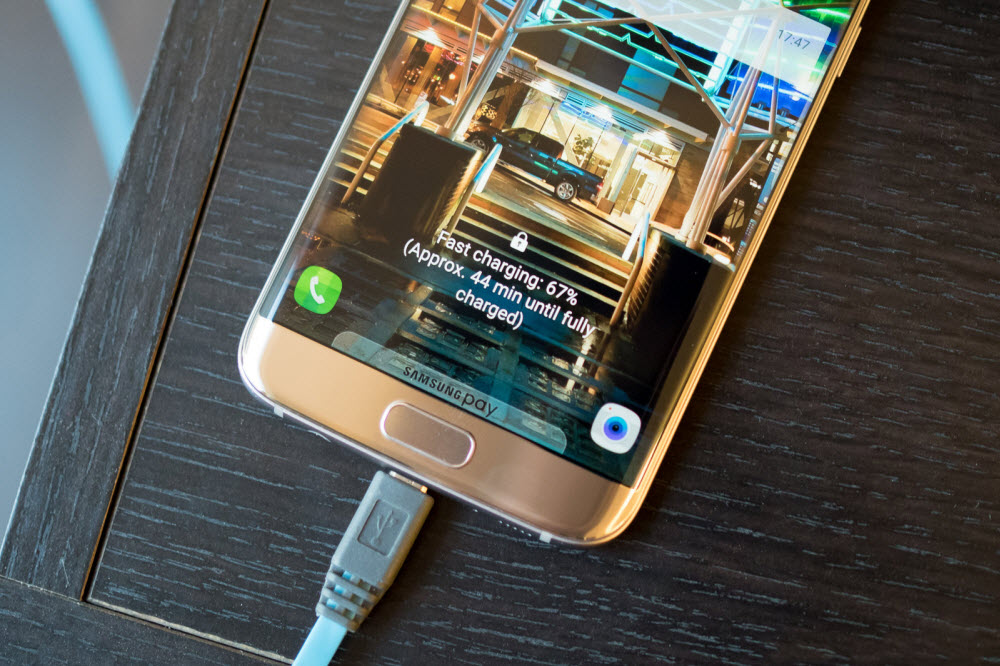
I think it’s clear here who has the advantage. If Apple doesn't do anything in the next generations, then I think we can see big changes.
Samsung's wireless charging has long been a source of slight envy. I'm so tired of constantly using wires.
Performance
As you understand, both devices are flagships and no matter what game or program you launch, it will run without problems.
All thanks to the quad-core Apple A10 Fusion 4 processor in the iPhone and the Exynos 8890 or Snapdragon 820 in the Galaxy. Samsung supplies different processors for different markets, but there is not much difference in power. ![]()
RAM iPhone 7/7 PLUS - 2 and 3 GB, Samsung Galaxy S7 - 4 GB. The numbers of all this are impressive and for some people on their computers it’s not all fun.
Also, as practice shows, the operating system plays a very important role. iOS always uses resources more efficiently and thanks to this, you can observe stable operation. 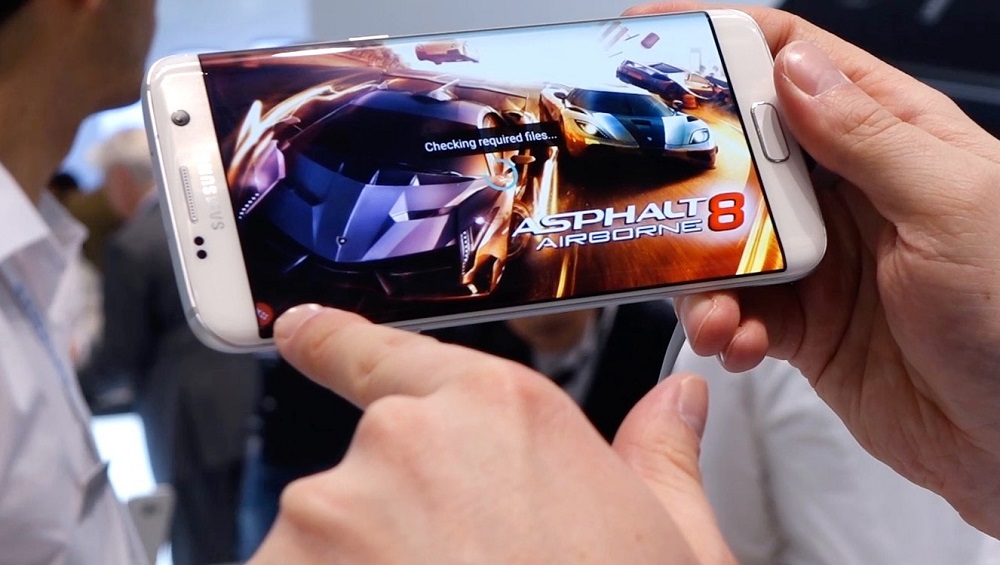
Android has made a big leap lately and is getting closer to optimization every day. iOS is still better, but I think in a year or two it won't be as noticeable.
Audio
I also decided to talk separately about music, because Apple has always been in first place. But if we compare the difference between before and now, the iPhone has long ceased to be top-end in this area. 
However, judging by the devices, there are quite a lot of differences. And for example, both iPhones have stereo speakers and lack a 3.5mm headphone jack.
The Samsung still has a jack and there is only one speaker, which also sounds quite good. 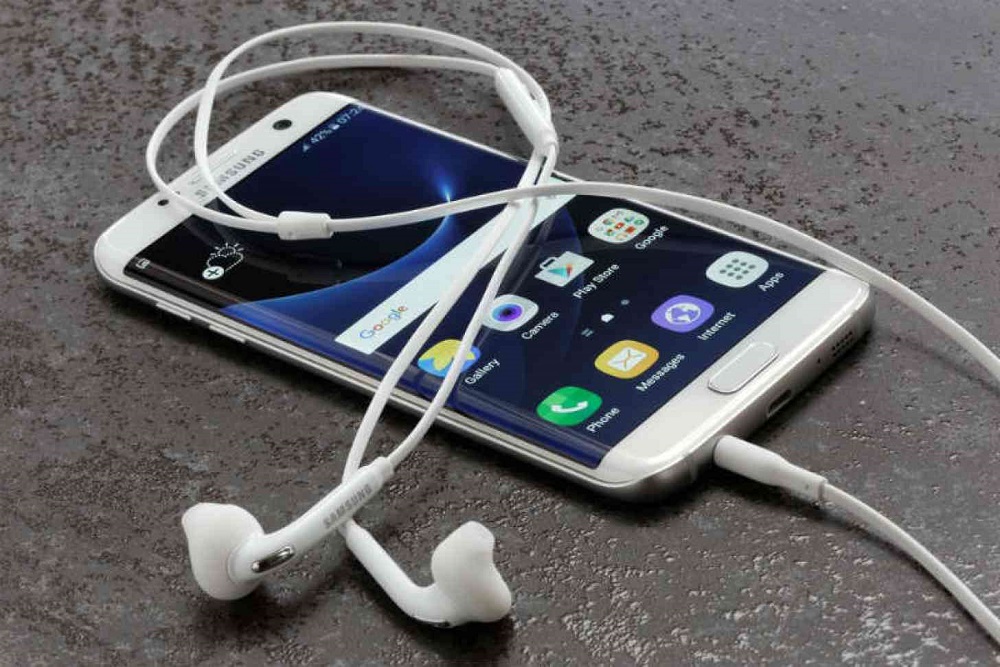
As for me, here I would give preference to the iPhone. After all, stereo speakers are much more expensive than jack speakers and you want to watch videos and play games at the highest level.
Moreover, bluetooth headphones They are becoming cheaper and in a couple of years, perhaps we will remember the 3.5 connector as CDs.
Camera
Now we have reached the most interesting point, which is usually the most interesting thing when buying a new smartphone. After all, photographs have become a part of our lives for about 2 or 3 years now. 
Main camera. Let's take the iPhone plus model as an example, because it has dual camera 12 MP each. The second is used for portrait mode and 2x optical zoom.
Samsung also has 12 megapixels. They reduced the number of pixels to increase the pixel size, which now combines two LEDs instead of the usual one.
If anyone understands, Samsung has an aperture of f/1.7, and Apple has an aperture of f/1.8. Which is very, very good for mobile phones.
Speaking about night photography and in low light conditions, the winner can be safely called Samsung, which has a much clearer picture. 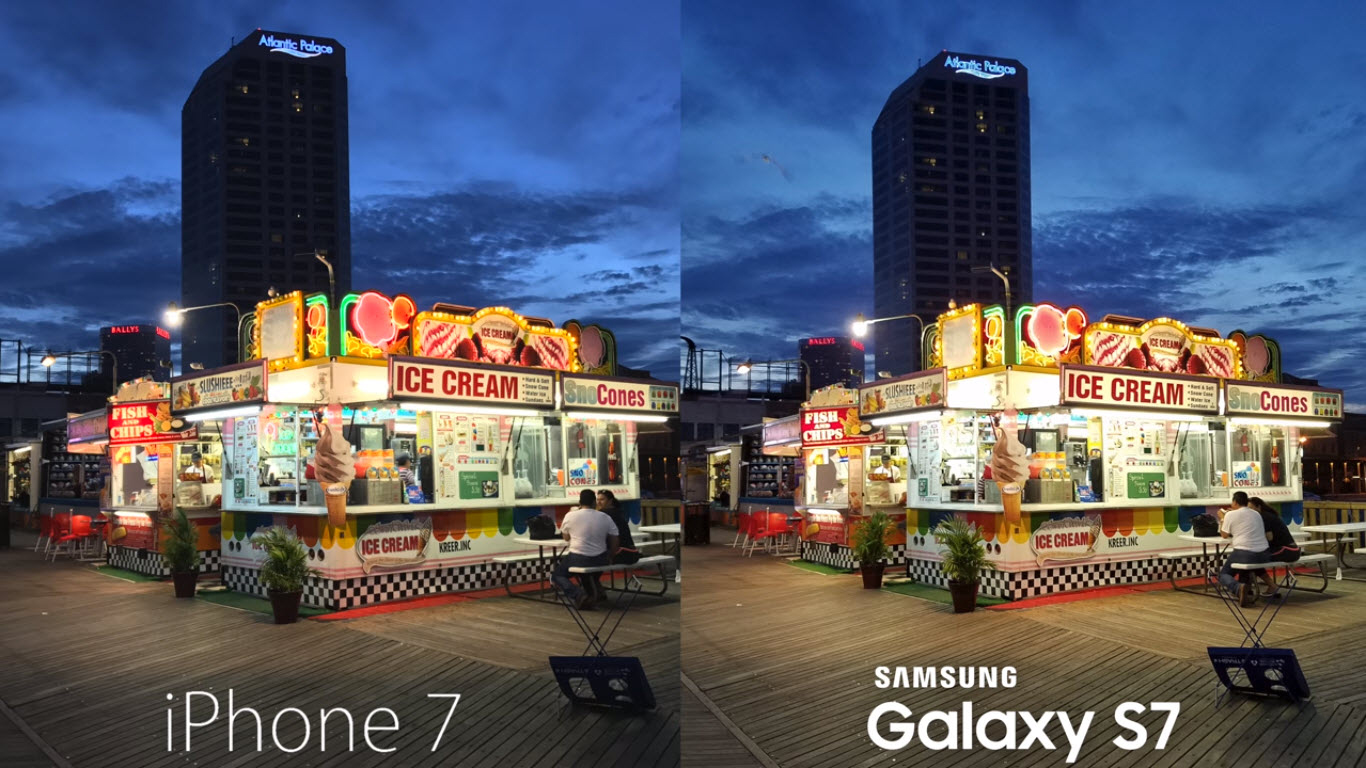
During the day, both devices cope quite well and the difference here is really not very big. Samsung wins a little, but not critically. 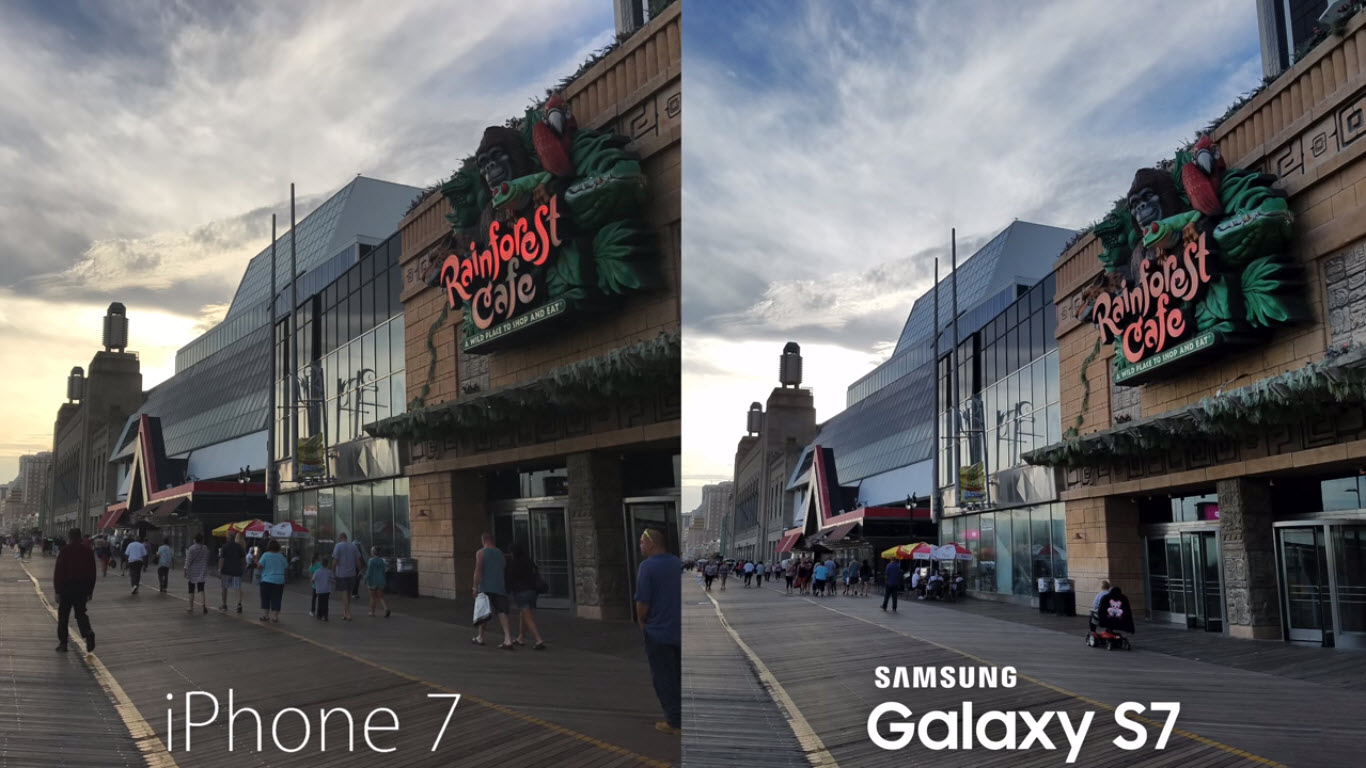
Reminds me of a time when Apple was the best in mobile photography. The days when they occupied top positions are long gone. Everything is about equal now.
If we briefly mention video, Apple does a little better here and has optical image stabilization, 4K recording (30 fps) and an A10 Fusion coprocessor - available in both the 7 and Plus versions.
Samsung also has optical stabilization and the ability to shoot in 4K. I think it's the lenses that make the difference.
Front-camera. Now let’s touch on a topic that has been haunting us for many years, and this is, of course, selfies, which many take several times a day. 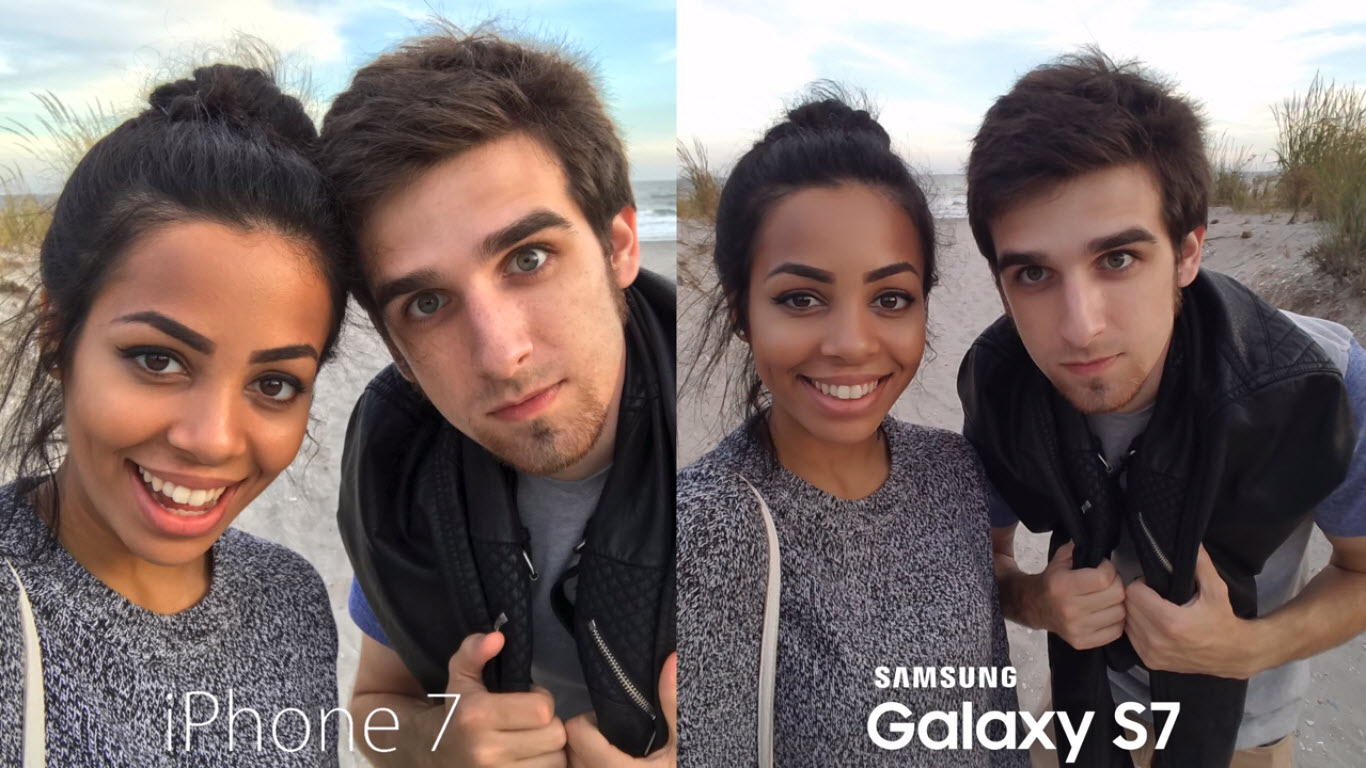
iPhone 7 has 7 MP, which takes very accurate photos and you can see all the smallest details of your face.
The Samsung S7 is only equipped with 5 MP, but it is wide-angle and you can capture much more detail in the photo.
Here you can choose for yourself, picture clarity or wide angle. In reality, each option is for different occasions and for example, if you take pictures with several people, then Samsung will probably do a better job.
Chips
If previously Apple dictated the rules of technology in the market entirely, now this happens only partially.
Let's quickly go over the main differences that I was able to notice:
- Taptic Engine and 3D Touch (iPhone). You feel very pleasant responses from the smartphone, which no other smartphone has yet. Just hold down on the icon and an additional menu appears.
- Menu button. iPhone equipped this time touch button Home, which creates the illusion of tapping thanks to Taptic Engine technology.
- Heart rate sensor and wireless charger Qi. You won't find all this on the iPhone. Galaxy is making great progress in this direction.
- Flexible camera settings. The principle of the iPhone camera is quite simple - point and take a photo. In Samsung, you can delve into the settings and do something pretty cool.
- Moisture protection. Available in both devices and Samsung has IP68 (can be located up to 30 minutes at a depth of 1.5 m).
Apple is a little worse in this regard and has an IP67 standard. 30 minutes at a depth of water up to 1 meter.
It turned out to be a bit of a vinaigrette, but I think I conveyed the essence of the rest of the chips and that’s the main thing. As you can see, they are completely two different devices.
Which is better than iPhone 7/7 PLUS and Samsung Galaxy S7/S7 Edge?
So, many people probably came to read the material so that they could understand what kind of smartphone is better and which one to buy for themselves. ![]()
I have a question for your answer, so no need to worry. In fact, the answer is very simple and you can decide right away.
You should check yourself using approximately these criteria and then you will be able to understand everything:
- Operating system. No matter what anyone says about an easy transition from Android to iOS and vice versa, this is a very difficult matter. Not in the sense that it is impossible to do.
The operating logic of each OS is completely different, and for example, if you like more freedom of action, then it will probably be Android. iOS is simple: turn it on, install it, use it.
So if you have a big dilemma, then just ask yourself what is more convenient and familiar to you. Why torture yourself with something new, just for the sake of what has changed? appearance devices.
- Price. It’s 2017 and as you understand, the prices of both devices are far from equal. You can already find an S7 at a price two times cheaper than at the start of sales.
This doesn’t happen with the iPhone yet, and even the older models are quite expensive. big money. And this applies to both used and new ones.
So if you have enough money for a Galaxy S7, you can get it at a great price and use it for the next two years. The design and functions will be relevant for another two years for sure.
- Camera. Given the fact that mobile photography is developing at a crazy speed, I can safely say that this criterion is simply incredibly important when choosing.
When compared in general, the cameras do not have too much of a difference in quality. It really all depends on what exactly you would like.
For example, in Samsung we get better quality pictures thanks to the possibility of flexible settings. The device also copes well in automatic mode.
Apple has a second camera and it could be the key. A cool portrait mode that can blur the background is getting better every day.
Also, the 2x optical zoom without loss of quality is also very impressive. If these two points are important to you, then you know what is better to buy.
I understand that there is no clear answer about best device no at all. After all, Samsung has been pushing hard with its technology and screen for a long time.
Just read the points and choose which category you belong to. If the choice is Samsung, then we take it without hesitation. 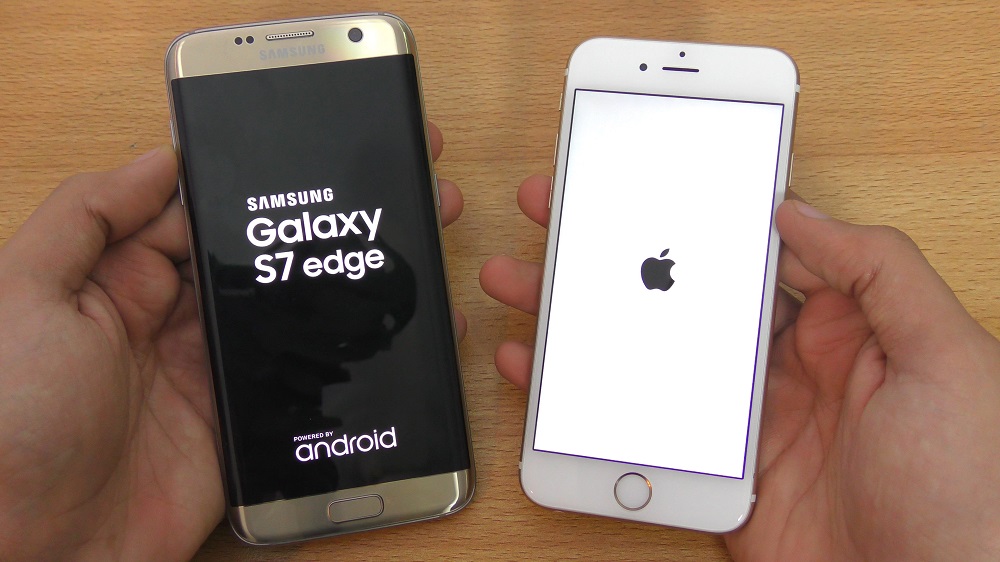
If it's Apple, then welcome to new world, where you don’t have to worry too much about the choice and your next smartphone will be very obvious.
My point is that it is much more difficult for Android users to choose a device, because there are too many brands that constantly release completely different devices.
Apple makes it simple. You buy a model that you have enough money for and you already roughly understand that in the future the choice will be between two models at most: the top-end and last year’s flagship.
Results
To be honest, choosing between such devices is always difficult. I hope my comparison of iPhone 7/7 PLUS and Samsung Galaxy S7/S7 Edge devices could make the overall picture at least a little clearer.
It is very difficult to put all thoughts in one article and therefore, we get this result.
To be honest, I can finally say the principle that I would follow: we take the device that we like externally and it will not lag for the next 2-3 years.
On this moment We spend a crazy amount of hours just sitting in front of our smartphones. We buy something that will delight you with all its functions.
In contact with
Classmates
Introduction
There are only two companies that sell smartphones at prices above $600 million. That is why comparison of devices Apple iPhone 7 and Samsung Galaxy S7 is so intriguing.
Apple brought more innovations to the iPhone 7 than expected, such as expanding the color range of the screen, a new sensor with optical stabilization, and a waterproof case. The IP67 rating previously gave the Samsung Galaxy S7 superiority over previous iPhone models, but now they are equal.
The Galaxy S7 offers a long list of features that should give it an edge over even the latest generation iPhone models, at least on paper. Could the iPhone 7, which appeared six months later, force one to choose itself over the S7, one of the best representatives of the Android camp?
Design
 The iPhone 7 and Galaxy S7 haven't changed much in appearance compared to the models from a year ago. Apple brought antenna strips to the iPhone 7 back cover on the side edges of the case, abandoned the physical Home button in favor of a touch button, removed the headphone jack, made the case waterproof, installed stereo speakers, increased the size of the lenses for the rear camera, offered two new color options (both black) and removed one old one. The changes made during the year are limited to this.
The iPhone 7 and Galaxy S7 haven't changed much in appearance compared to the models from a year ago. Apple brought antenna strips to the iPhone 7 back cover on the side edges of the case, abandoned the physical Home button in favor of a touch button, removed the headphone jack, made the case waterproof, installed stereo speakers, increased the size of the lenses for the rear camera, offered two new color options (both black) and removed one old one. The changes made during the year are limited to this.
Premium materials, portability and controllability in the palm of your hand remained unchanged in 2016, since the screen diagonal is not the largest by modern standards. At the same time, the S7 is larger and slightly heavier, a feeling contributed to by the thicker body.
Apple ditched the physical Home button in favor of a pressure-sensing, haptic Home button, while Samsung uses an elliptical, clicky button. The button protrudes from the S7; it can be easily scratched during daily use of the device, whereas on the iPhone 7 it can be damaged Home button much more difficult. You need to get used to the version on iPhone 7, both when switching from the device to Android, and from previous ones iPhone models, but it won't take much time.
Screen
The iPhone 7 uses a 4.7-inch LCD screen with a resolution of 750 x 1334 pixels, while the S7 has a 5.1-inch 1440 x 2650 AMOLED screen. In terms of pixel density, the advantage with a margin is on the side of the S7, but the HD resolution on the iPhone is quite sufficient for this diagonal, while Quad HD at 5 inches is overkill and consumes a lot of energy.
Speaking of power, the S7 can offer brightness levels of around 500 nits, while the iPhone 7 is capable of over 600 nits, making it easier to use in the sun.
In terms of color reproduction, the iPhone has an advantage. It's the first smartphone with active color management to use the DCI-P3 cinematic color space (Apple calls it "wide color gamut"), which should be enough for the next few years. On the Galaxy S7, you need to purposefully select a base color mode so that the screen displays common color range sRGB, whereas in the default adaptive mode the colors are cold and oversaturated. Apple since iOS 9 uses active control color, so when the image inside is labeled as sRGB, it is displayed as such on the iPhone 7 screen, and if a richer color range like P3 is specified, then the screen adapts to it. The user does not need to select color modes himself.
As for viewing angles, both are at a good level, although AMOLED, even in basic mode, becomes colder and bluer at the slightest tilt of the device. Among additional features screens: iPhone is equipped with 3D Touch technology, which recognizes the pressure applied and reacts accordingly. Apple, as well as third-party developers, are increasingly using this feature, although it is not yet indispensable. Samsung takes advantage of OLED technology for the Always-on screen, showing the date, time, notifications, etc. when the main screen is turned off. This saves energy.
Interface and functionality
The confrontation between the iOS and Android systems in these devices is carried out on the highest level. iPhone 7 runs on new version iOS 10, but the Galaxy S7 is no longer new Android 6.0 Marshmallow with TouchWiz skin on top.
iOS 10 was updated not only internally, as was the case with iOS 9 a year earlier. Apple introduced new system widgets, a redesigned lock screen, updated the Messages application, and opened chat and Siri to third-party developers. The result has been an influx of widgets not only for pre-installed applications, but also for options from the store App Store. While they may not be as interactive or customizable as Android's, iOS widgets are neatly laid out on their own screen, displaying the most up-to-date and interactive information that eliminates the need to open an app to check, which is what widgets were designed to do. Moreover, you can display them by pressing harder on the application icon, without even going to the widgets screen.
You can also note the communication switches and player controls that are called up by swiping from the bottom of the screen, whereas in TouchWiz you need to swipe up to open the notification panel.
iPhone 7 can wake up the screen automatically without pressing the side or Home buttons when the device is tilted. Samsung has endowed the Galaxy S7 with no less useful option— a quick double tap on Home when the screen is locked opens the camera application so as not to miss the necessary fleeting shot. iPhone allows you to access the camera from the lock screen by swiping left.
Processor and memory
Apple uses new processor A10 Fusion, Samsung uses Exynos 8890 in the S7, also of its own manufacture. Both are made on a modern 14/16 nm process technology, both are fast and energy efficient. Apple beats all competitors in benchmarks, especially in the graphics category, while Samsung uses an ARM-Mali graphics chip with more modest results. Part of the reason is the lower resolution iPhone screen. In any case, both devices are very fast and only the heavy TouchWiz shell prevents the Samsung device from showing the full potential of its processor. For example, applications launch a little slower than on the iPhone.
Apple has equipped the iPhone 7 with a volume random access memory 2 GB, while the Galaxy S7 has 4 GB of memory, but on iOS there is high-quality memory management, which helps to cope even with dozens of applications running simultaneously. TouchWiz and Android constantly take up a significant portion of that 4GB.
When it comes to storage space, Apple has been more generous than usual this year, with the minimum on the iPhone 7 being 32GB, the same as the Galaxy S7. Next come versions with 128 and 256 GB, the cost of which differs by $100. Samsung also offers a card slot microSD memory, which may have more capacity but is slower.
Browser and connection
Apple uses time-tested own browser Safari, while Samsung offers both its own browser and Chrome. Apple and Samsung browsers are distinguished by fast page processing; reading modes eliminate advertising and unnecessary images, leaving only text.
iPhone 7 supports up to 25 LTE bands versus 20 for the S7, which is a record value for a smartphone and allows you not to worry about communication anywhere in the world with access to 4G. The iPhone also supports LTE category 12 with downstream speeds of up to 600 Mbit/s, while the S7 has LTE category 9 and 450 Mbit/s. All other traditional standards wireless communication are also present.
When it comes to cable connections, Apple has a proprietary Lightning connector that plugs into the iPhone 7. EarPods headphones, and the S7 has a microUSB at the bottom.
Camera
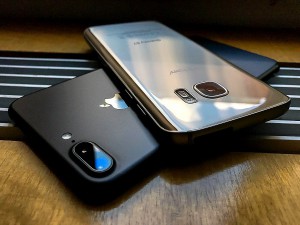 No one doubts that these flagship smartphones have the fastest processors, memory and other hardware components, so the main issue is the quality of the camera, the resolution of which in this case is 12 megapixels. We can immediately say that the cameras here are quite good, or rather, the best in modern smartphones.
No one doubts that these flagship smartphones have the fastest processors, memory and other hardware components, so the main issue is the quality of the camera, the resolution of which in this case is 12 megapixels. We can immediately say that the cameras here are quite good, or rather, the best in modern smartphones.
On paper, the camera specs for both devices are similar - 1/2.6-inch sensor and f/1.8 aperture for the iPhone 7, 1/2.5-inch and a wider f/1.7 aperture for the S7. These are larger than most modern smartphones sensors and apertures, so you can expect appropriate photo quality. Camera apps give you access to all the basics a fashion blogger might need, like HDR, panoramas, color effects, manual settings and live photographs with animation. When it comes to photographing speed, the S7 was the leader in focusing and photographing time, but the iPhone 7's image processing has been greatly improved, so the device is the leader in this regard. However, both take photos very quickly.
Photos from the iPhone 7 have balanced, natural colors, unlike the overly warm tones of the previous generation of iPhones, but at times the color appears too dull. The Galaxy S7 produces a yellowish tint in many photos, tilting the white balance towards a warmer side. At first glance, the Galaxy S7 appears to offer more detail, but this can be attributed to being overly sharp, which looks artificial. When it comes to dynamic range, both phones perform well, although the iPhone tries not to overdo it with bright objects or clouds, resulting in a darker overall frame. Galaxy does not care about such subtleties and the device can overexpose the sky, merge all the clouds together, but objects on the ground are brighter and better visible.
Low light photos are also good, the best in smartphones. The Galaxy S7 has a visibility advantage, brighter exposure and warmer white balance, as well as the same over-sharpness. The iPhone 7 produces more natural photos at night and in low light, with a more natural white balance than the yellow tint of the S7. Both cameras resist digital noise well, and even photos on the Galaxy that undergo more software processing are not marred by a lot of artifacts. However, the extra sharpness does contribute and the S7 still has more noise than softer photos from the iPhone 7.
Both smartphones record 4K video at 30fps, 1080p at 60fps, and slow motion. Samsung system The Dual Pixel on the S7 remains elusive when it comes to focusing, switching between far and near objects is instantaneous. The iPhone 7 also has fast continuous autofocus, but still hesitates momentarily when switching between subjects.
The devices record video smoothly, without jitter, since they have optical stabilization Images. The iPhone 7 does a better job of shooting in motion, while the S7's footage is brighter, warmer, and sharper. The iPhone 7 has darker videos and softer details. When shooting video, stereo sound is recorded.
Multimedia
Apple has redesigned the Photos gallery in iOS 10, improving facial recognition and search. Samsung offers a Gallery app for photos and videos, which is fast and minimalistic, with editing capabilities.
When it comes to audio playback, Apple leads the way with its streaming service integrated into the player. Samsung relies on a separate player, which is not very attractive in appearance, but offers a variety of modes and equalizer settings.
The iPhone 7 delivers better audio thanks to stereo speakers, one on top and one on the bottom. While the waterproof compartments won't wow you with sound quality, they're enough to beat the single speaker on the S7.
Call quality
Upper iPhone speaker 7 is located in the auricle, the sound is loud and clear, so you can hear the interlocutor without problems. There are three noise-cancelling microphones that transmit high-quality voice sound to the interlocutor.
The S7 also does not disappoint in terms of the quality of phone conversations; the voice is transmitted clearly and without distortion. The microphones do their job as expected.
Autonomy
The iPhone 7 received a battery with a capacity of 1960 mAh, which provides battery life for 7 hours 46 minutes with the screen on in a proprietary benchmark. This is not a particularly impressive value, but not bad for such a capacity, which should be enough for a full day of average use of the device. If you don't play Pokemon Go for 4 hours, then there shouldn't be a problem. There is no fast charging, just like wireless charging; the charging process from zero takes 2 hours and 20 minutes, which is far from the fastest.
The Galaxy S7 has a 3000 mAh battery, but it only gave out 6 hours 37 minutes, which should also be enough for a day, but is unlikely to last a couple of weekends away from a power outlet. To compensate for this shortcoming, fast charging is offered, wired and wireless. The device charges from zero to maximum in an hour and a half.
Conclusion
If the Galaxy S7 expected a simple victory over the iPhone 7, which received a minimal number of innovations, then the expectations were in vain. Apple managed to be better in terms of duration battery life, color rendering, outdoor visibility, audio quality - those components that are close to average users. The wider color rendition of the screen and the camera are already worth upgrading to this model, since the existing capabilities will last for at least a couple of years. If we also remember about the improved operating system iOS 10, software iPhone capabilities have never been so extensive and high quality.
In contact with
